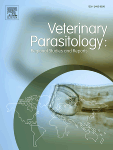View Item
- xmlui.general.dspace_homeCentros Regionales y EEAsCentro Regional Buenos Aires SurEEA BalcarceArtículos científicosxmlui.ArtifactBrowser.ItemViewer.trail
- DSpace Home
- Centros Regionales y EEAs
- Centro Regional Buenos Aires Sur
- EEA Balcarce
- Artículos científicos
- View Item
Isolation of Neospora caninum from a beef cattle fetus from Argentina: Immunopathological and molecular studies.
Abstract
Neospora caninum is an important abortifacient agent affecting mainly cattle worldwide. The aim of the present work was to describe the histopathological findings in a naturally infected beef cow and its midterm fetus caused by a genetically defined N. caninum isolate in Argentina. A N. caninum seropositive multiparous Aberdeen Angus pregnant cow and its fetus in the sixth month of gestation were submitted for histopathological, immunohistochemical,
[ver mas...]
Neospora caninum is an important abortifacient agent affecting mainly cattle worldwide. The aim of the present work was to describe the histopathological findings in a naturally infected beef cow and its midterm fetus caused by a genetically defined N. caninum isolate in Argentina. A N. caninum seropositive multiparous Aberdeen Angus pregnant cow and its fetus in the sixth month of gestation were submitted for histopathological, immunohistochemical, serological, and molecular studies and parasite isolation. The cow belonged to a beef herd under extensive management, with a N. caninum seroprevalence of 11%, and low level of annual abortion rate (≤ 5%). The dam had mild lymphocytic infiltrate in CNS, heart and uterus and no parasites were detected by Immunohistochemistry (IHC). No parasitic DNA was detected in the dam's brain, and gamma interferon knockout mice inoculated with brain material did not become infected. Clusters of tachyzoites and parasitic DNA were detected in the placenta by IHC and PCR, respectively. However, isolation from the placenta was unsuccessful. The fetus developed specific antibodies and an inflammatory response was detected in multiple organs. Furthermore, in vitro and in vivo isolation was achieved from gamma interferon knockout mice inoculated with CNS from the fetus. Multilocus-microsatellite typing revealed a genetically defined N. caninum isolate similar to the previously reported as MLG 72. We report the first N. caninum isolate from beef cattle in Argentina.
[Cerrar]

Author
Campero, Lucía María;
Gual, Ignacio;
Dellarupe, Andrea;
Schares, Gereon;
Moré, Gastón;
Moore, Prando Dadin;
Venturini, María Cecilia;
Fuente
Veterinary Parasitology: Regional Studies and Reports 21 : 100438 (2020)
Date
2020-07
Editorial
Elsevier
ISSN
2405-9390
Formato
pdf
Tipo de documento
artículo
Palabras Claves
Derechos de acceso
Restringido
 Excepto donde se diga explicitamente, este item se publica bajo la siguiente descripción: Creative Commons Attribution-NonCommercial-ShareAlike 2.5 Unported (CC BY-NC-SA 2.5)
Excepto donde se diga explicitamente, este item se publica bajo la siguiente descripción: Creative Commons Attribution-NonCommercial-ShareAlike 2.5 Unported (CC BY-NC-SA 2.5)

